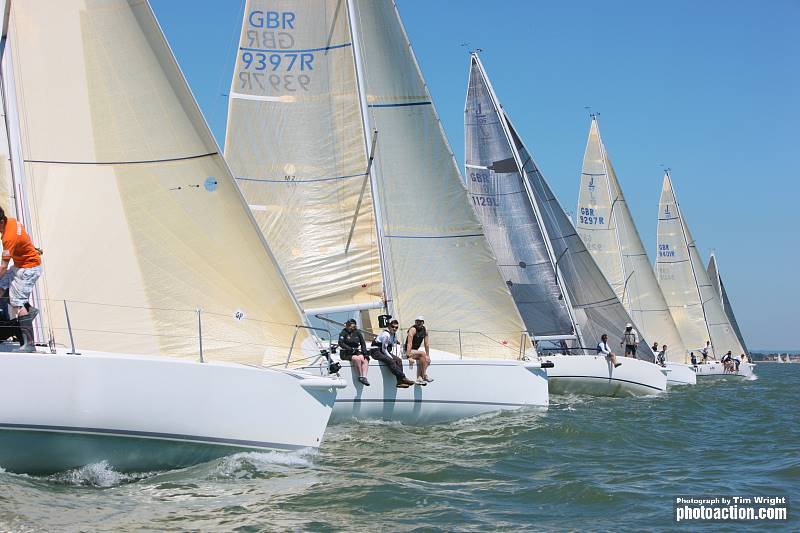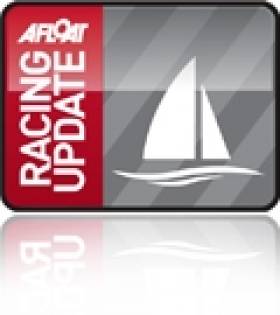Displaying items by tag: J boats
Three Races in Shorts and Shades in the J boats Cup
Thursday 3rd of June was the first day of racing at the J-Cup 2010, hosted by the Royal Southern Yacht Club in Hamble. The entry of 74 J Boats includes 27 J/109s which are racing for the 2010 J/109 UK National Championship title. The Principal Sponsors of the J-Cup 2010 are B&G, Dubarry of Ireland, North Sails and Universal Marina and each of them have staff sailing at the event. Conditions on the Solent yesterday were spot on; 6 to 15 knots from the South East and sparkling sunshine. The six class racing at the event, including the J/109s and each completed three races on the first day of the regatta.
Ian Matthews and his family team on board the J/122 Jinja dominated IRC 1 on the opening day with three straight wins, and achievement that earned Jinja the North sails Boat of the Day prize. Herman Bergshaven’s J/133 Solnes III, visiting the UK from Spain, had a great day, especially considering that the first time he had met most of his guest crew was at the preparatory signal for the first race. He sits in second place at the end of Day One and David Hunt’s J/122 Jacobs Ladder is currently lying third.
Eighteen J/80s are racing at the J-Cup 2010 and the fleet includes a number of new owners as well as two boats which are racing for the charity Toe In The Water. Steve Mittler’s young Team Baltic from Devon lead this one-design class with John Cooper’s Oi! just a point behind. Gordon Craigen, who took delivery of his J/80 Swallow just two weeks ago, is in third place. Team Baltic was named as the North Sails Boat of the Day but other notable results here include those of Brian Moreton who is racing the J/80 Juicy for the first time at this event. He is currently lying in an extremely creditable fourth place. Brian is more usually seen towards the front of the J/109 fleet in Juke Box.
North Sails Boat of the Day in IRC 2 is the J/97 Jika Jika, owned and raced by Mike and Jamie Holmes. Three wins yesterday for this team places them firmly at the top of the rankings at the end of Day One. Grant and Brigitte Gordon are in second place in their J/97 Fever Jr. This a great start for Fever Jr. especially when you consider that the J-Cup 2010 is her first regatta! In third is Mike Flood in his J/97 Indulgence, another brand new boat delivered just a few weeks ago. These J/97 guys clearly hit the water running and it will be interesting to see how each improves, race by race, over the next two days of the regatta.
Some of the closest ‘snakes and ladders’ racing yesterday took place in the J/105 Class with three different boats each winning a race. Rob Dornton-Duff’s Java took the bullet in Race One, the honours went to Richard Watney’s Jeopardy in Race Two and Race Three was won by William Newton and his crew on Jelly Baby. A 2,2,1 scoreline places Jelly Baby in pole position for the J/105 Class at the end of Day One and Jelly Baby was also selected as the North Sails Boat of the Day. Java lies second at the current time with Jeopardy in third place.
The fiercely competitive J/109 UK National Championship fleet were racing yesterday under the watchful gaze of a jury boat for the first time. The new J/109 Class Chairman, Adam Wright’s crew on board Velvet Elvis are right on the pace at the moment and three clear wins yesterday place them firmly at the top of the scoreboard. It also earned them the North Sails Boat of the Day prize. David and Kirsty Apthorp, who currently hold the J/109 UK National Championship title with their crew from J-Dream are second after the first day, David McLeman’s Offbeat is currently third overall, Stephen Tapper is fourth in Stalker and Matt Boyle’s Shiva is fifth as we go to press. The Race Committee for the J/109 fleet reported ‘the closest photo finish ever seen’ for Race Three, between Velvet Elvis and David Aisher’s Yeoman of Wight. We love that!
Three races are scheduled for Friday and conditions are forecast to be similar to the opening day, with sun and wind and hot competition throughout. If the J-Cup fleet didn’t quite manage to quench their thirst at the Universal Marina Opening Party after racing on Thursday, they can relax safe in the knowledge that they will return to shore later today to be entertained at the B&G ‘Dark & Stormy’ Party. Yippee!






























































